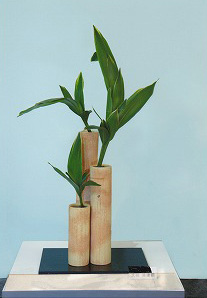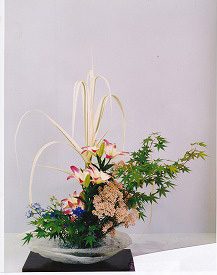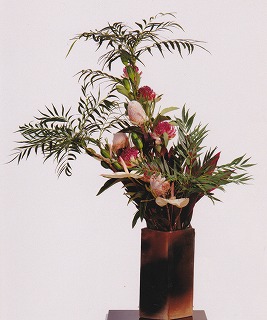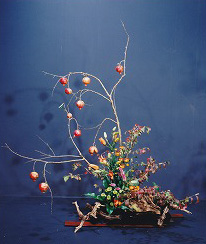|
※青=英語 緑=中国語 |
成和御流へようこそ
Welcome to Seiwagoryu 欢迎来到成和御流
家元の詞
一輪の花、草木に魅せられて・・・
A Word from Iemoto
Be captivated by every single flower and plant…
家元之言
被一朵花、一棵草木深深吸引…
花の命は短く、一瞬の輝きを放って散ってゆきます。その一瞬の煌めきを愛おしみながら、その美しさの一つ一つを器に映し出し、澄んだ空気と共にくつろぎの空間を創り出して参ります。
成和御流では、450年前に創流され培われた伝承花と、その風合いである“言外の趣味が漂う作品”を心掛け、現在の暮らしに合ったいけばなをご提案いたします。
更に当流のインペリアルフラワーアレンジメントでは、インテリアとしての花を、しっかりとしたファウンデーションワークをベースに、形のあるものは何でも花器にして花あしらいを考案し、自由に美しく形にしていきます。
”もっと身近に、もっと美しく、もっと楽しんで、花と暮したい” それが私達の願いです。
The life of a flower is short, it scatters after an ephemeral bloom. However, we cherish that momentary glory, present each of their beauty on a vessel, and create a relaxing place with fresh air.
At Seiwagoryu, we propose Ikebana ideas suitable for the current lifestyle, based on traditional flower arranging styles that were created and developed from 450 years ago, as well as works that express a kind of “implicit preference”.
Furthermore, with a strong foundation work, our imperial flower arrangement allows you to turn anything with a shape into a vase and make a beautiful arrangement freely.
We wish that you could get closer to flowers, make them more beautiful, enjoy the work and feel like want to live with them.
花的寿命短暂,在绽放一瞬间的光芒后就散落。在欣赏那瞬间的光辉的同时,我们将它的每一种美投射到器皿上,营造一个空气清新的放松空间。
在成和御流,我们将以450年前创建后发扬至今的传承花及带有其风格的有趣作品为您提供适合您当前生活的华道。
另外,我们的宫廷花艺课程将为您提供扎实的基础技能,以花卉作为室内装饰,并让您自由选择任何一种形状的花瓶打造您所要的优美造型。
我们希望能让您想要更亲近花朵,把它们变得更美丽,也更享受有花卉的生活。
教室のご案内
Lessons 课程资讯
成和御流教室ご案内
Information of Seiwagoryu lessons 成和御流课程资讯
初めての方にはわかりやすく丁寧にプロをめざす方にはじっくりと御教授致します。四季折々の花で心安らぐひとときを味わいましょう。お気軽にお尋ねください。
For beginners, the method of instruction is very simple to help you understand better; for those who aim to become professionals, we will be teaching attentively. Let’s have a wonderful relaxing moment with seasonal flowers. Please feel free to contact us for any inquiry.
对于初学者我们会以简单易懂的方式细心教导,并为旨在成为专业人士的人精心教授。
让我们与时令鲜花一起享受轻松的时光。若有任何疑问,请随时联系。
家元教場 (家元指導教室)
福岡県糟屋郡新宮町三代西1丁目6-1
TEL・FAX TEL/FAX 092-963-3857
Iemoto classroom (lessons by Iemoto)
1-6-1 Mishironishi, Shingu, Kasuya District, Fukuoka
TEL・FAX TEL/FAX 092-963-3857
家元指导教室
福岡県糟屋郡新宮町三代西1丁目6-1
TEL・FAX TEL/FAX 092-963-3857
●いけばな教室
水曜日 月3回コース(月1回、2回でも大丈夫です)
木曜日 月3回コース(月1回、2回でも大丈夫です)
土曜日 月3回コース(月1回、2回でも大丈夫です)
Ikebana Classes
Wednesday: 3 times a month course (can be once or twice a month)
Thursday: 3 times a month course (can be once or twice a month)
Saturday: 3 times a month course (can be once or twice a month)
华道(日式花艺)教室
星期三:每月3次课程 (一个月只出席1,2次也可)
星期四:每月3次课程 (一个月只出席1,2次也可)
星期六:每月3次课程 (一个月只出席1,2次也可)
●いけばな・アレンジ(IMPERIALフラワーアレンジメント)
月2回コース
●Ikebana & Imperial Flower Arrangement
2 times a month course
●华道、宫廷花艺
每月2次课程
●フラワーアレンジメント教室
月1回~ (IMPERIAL フラワーアレンジメントのお免状も取得出来ます)
●Flower Arrangement Classes
Once a month~ (You will be able to get a certificate for Imperial Flower Arrangement)
●花艺教室(西式)
每月1次课程 (可获取宫廷花艺证书)
※お時間はご相談に応じます。
月謝・花材代・その他お問い合わせは、 FAXまたはお電話にてお気軽にお尋ねください。
*You may consult us to arrange the time.
Please feel free to contact us by fax or phone for inquiries such as monthly lesson fees and costs for materials.
*请咨询我们安排方便您的时间。
关于每月学费,花材费用等疑问,欢迎通过传真或电话随时与我们联系。
そぴあしんぐう
新宮町文化協会内
TEL 0902-963-3805
Sopia Shingu
Inside Shingu Cultural Association (Shingu-machi Bunka Kyoukai)
TEL 0902-963-3805
Sopia Shingu
新宮町文化协会内
TEL 0902-963-3805
●成和御流お華塾 開催中(詳しくはお尋ねください)
対象 子ども教室・成人誰でもオーケー教室
内容 いけばな・アレンジ・お茶教室
天神アイカルチャ―教室(家元指導教室)
●Seiwagoryu Ohana Juku (flower arrangement lessons): Ongoing (please contact us for further information)
Open for: Children and adults
Content: Ikebana, imperial flower arrangement, tea ceremony
Classroom at Tenjin I-Culture (lessons by Iemoto)
●成和御流花艺教学 举办中(详情请咨询)
对象:儿童与成人
内容:华道,宫廷花艺,茶道
Tenjin I-Culture教室(家元指导教室)
福岡市中央区天神4-3-20 ノース天神8階
TEL 092-721-3200
第3火曜日 15時半~ (詳しくはお尋ねください)
8F North Tenjin, 4-3-20 Tenjin, Chuo Ward, Fukuoka City, Fukuoka.
TEL 092-721-3200
3rd Tuesday of the month 3:30pm~ (please contact us for further information)
福岡市中央区天神4-3-20 North天神8楼
TEL 092-721-3200
第三个星期二 下午3点半~ (详情请咨询)
福岡女子大華道部教室 (家元指導教室)
Kadou (flower arrangement) classroom at Fukuoka Women’s University (lessons by Iemoto)
福冈女子大华道部教室(家元指导教室)
*その他、各地に成和御流教授指導教室がございます。よろしければお尋ねください。
* There are other Seiwagoryu classrooms in different places so please don’t hesitate to contact us for details.
*除了以上地点还有其他成和御流教授指导教室。请联系我们咨询有关详情。
体験教室のご案内 Trial Lessons 课程体验资讯
無料体験(1回)
レッスン料無料。
体験レッッスンの種類・・・いけばな フラワーアレンジ お茶
花材費ご負担(2日前までに要予約)。
Free trial (1 time)
No lesson fee required
Trial lesson available: Ikebana, western flower arrangement, tea ceremony
Costs for materials are to be borne by participants (reservation required at least 2 days in advance)
免费体验 (1次)
免学费
课程体验种类:华道,西式花艺,茶道
花材费用需自付(请至少提前2天预订)
家元教場
福岡県糟屋郡新宮町三代西1丁目6-1
TEL・FAX 092-963-3857
Iemoto classroom
1-6-1 Mishironishi, Shingu, Kasuya District, Fukuoka.
TEL・FAX 092-963-3857
家元教场
福岡県糟屋郡新宮町三代西1丁目6-1
TEL・FAX 092-963-3857
天神アイカルチャ―教室
福岡市中央区天神4-3-20 ノース天神8階
TEL 092-721-3200
Classroom at Tenjin I-Culture
8F North Tenjin, 4-3-20 Tenjin, Chuo Ward, Fukuoka City, Fukuoka.
TEL 092-721-3200
天神I-Culture教室
福岡市中央区天神4-3-20 ノース天神8階
TEL 092-721-3200
そぴあしんぐう教室
新宮町文化協会内 新宮町文化协会内
TEL 092-963-3805
Sopia Shingu Classroom
Inside Shingu Cultural Association (Shingu-machi Bunka Kyoukai)
TEL 092-963-3805
Sopia Shingu教室
新宮町文化协会内
TEL 092-963-3805
お問い合わせは、FAXまたはお電話にてお尋ねください。
Please feel free to contact us by fax or phone for further details.
若有任何疑问,欢迎通过传真或电话随时与我们联系。
お問い合わせ先
成和御流: 家元 大嶋由紀圃
住 所 〒800-0125 福岡県糟屋郡新宮町三代西1丁目6-1
TEL・FAX 092-963-3857
Contact
Seiwagoryu: Oshima Yukiho (Iemoto)
Address: 1-6-1 Mishironishi, Shingu, Kasuya District, Fukuoka
TEL/FAX: 092-963-3857
联系方式
成和御流:家元 大嶋由紀圃
地址:〒800-0125 福岡県糟屋郡新宮町三代西1丁目6-1
TEL/FAX: 092-963-3857
花型 Flower Styles 花型

お生花(おせいか)
天地人陰陽和合の形をかたどった格花。
天の役枝を体と呼び、高く、地の役枝を留と呼び、低く、人の役枝を用と呼び、その中間に置く。
本来、単一の木物、草物、花を使い、その出生をいかす。
足元を揃えて、虚実等分した姿とする。
Oseika
A Kakuhana (also known as Seika, a stately flower style) inspired by the harmony among heaven, earth, human, yin and yang energies.
The Yakueda (the main stem) of “Ten (heaven)” is tall and is called “Tai”; the low Yakueda of “Chi (earth)” is called “Tome”; whereas the Yakueda of “Hito (human)” which is usually placed in the middle is called “Yō”.
We use a single branch, piece of grass, or flower, to create the best arrangement.
Align the bottom of the stems and create a good balance between “Kyo” and “Jitsu”. (Kyo: removing unnecessary leaves or flowers; Jitsu: make use of the natural beauty of the flowers)
生花
取自天地人阴阳和合形态的格花。
天的役枝称作“体”,较高;地的役枝称作“留”,较低;人的役枝称作“用”,置于中间。
以最原始的一花一草一木做造型。
将底部对齐并使“虚”与“实”均匀分开。(“虚”指的是去除不必要的叶子与花朵,“实”则意味着展现花朵原始的姿态)

盛り花(もりばな)
その名の通り、盛っていける。
多種の花材を使い、角度をつけていける為、短い花や数の少ない木や草を組み合わせていけることを可能にする。
足元を揃えず、ゆったりといける。
主に低い水盤、コンポート、鉢などにいける。
Moribana
Do the arrangement as how the name suggests – fill it up (from the meaning of “moru” in Japanese).
You may use various types of flowers and arrange them in different angles, so it is possible to combine short flowers and a small number of branches or grasses.
Also, there is no need to align the bottom of the stems.
It is mostly done on lower flowerpots, basins, or containers.
盛花
顾名思义,将花朵“盛”在器皿内。
由于可以使用多种花材和从不同角度插花,您可以将较短的花和树枝或草组合在一起。
无需对齐底部,轻易做造型即可。
主要使用较低的花盆或其他容器。

投入れ(なげいれ)
その名の通り、投げて入れる花。
花留めには留め木や、花材に仕掛けをする。
多種の花材を使っていける。
主に丈の高い花瓶や壷を使用する。
Nageire
“Nageire” literally means “throw in”.
Place the flowers and stems on a kenzan and arrange them.
Usually, many types of flowers are used, and often go with tall vases.
投入
顾名思义,将花朵“投入”容器中。
将花朵和树枝插在剑山插花器上做造型。
一般使用多种花材,容器则主要使用较高的花瓶。

自由花
主に決まりのない自由な花。オブジェ。
空間を自由に描く。
花器も決まりはなく、多種多様な物を使っていける。
Jiyuka (Free style)
Usually there is no rules, you can arrange the flowers, objects, and spaces as you like. You will have a wide variety of options for vases too.
自由花
没有规则的自由花型。您可以随意利用空间和选择各式各样的花瓶。
いけばなのルーツ The Origin of Ikebana 华道的由来
往古、日本人は、山々を覆う森の多くの常緑樹“常磐なる木”が、緑の葉を年中茂らせる姿に、生命の永遠を見て、枯れてしまったかのように見えて、再び蘇る落葉樹の姿に、神の存在を意識し、独特の樹木信仰 “神よりますもの”(依代信仰)を持つようになりました。
今でも神社や神棚に榊をお供えし、新築等の地鎮祭には、榊をたてます。又、お正月にその年の年神様をお招きする為に門松を飾ります。能舞台の背景には、依代として松が描かれています。
このように、日本人は四季折々の自然と共に暮らしながら、草木に深い親しみを持ち、単に美的対象としてだけでなく、草木を極めて霊性の高いものとし、一枝の花木にも、深い風興を覚えました。そして、花と出会い、花の美を見つめ、語り合い、ここに花は、”お花“となっていきました。
6世紀になって大陸から仏教文化が伝来すると、仏に花を供え(供花)、花を飾る習慣が、人々の暮らしの中に溶け込んでいきました。
一方、神仏に関係ないところで、単に美しい花を飾ったという表現が歴史上、初めて登場するのは、9世紀(平安時代)になってから、「古今和歌集」に“花をさす”という言葉が現れました。今から、およそ1100年前です。
その後、「枕草子」の中に、“高欄のもとに青き瓶(かめ)の大きなるを据ゑて、桜のいみじうおもしろき枝の五尺なるを、いと多くさしたれば“と記され、いけばなは、“花をさす”という言葉から“挿花”と呼ばれるようになっていきました。後に、花を “いける” という言葉が使われるようになり、“いけはな” と呼ばれ、“いける” は、挿ける、生ける、活ける等と、様々な漢字が使われることにより、現代では、総称して“いけばな”と呼ばれています。
それから後に、花矩(はながね)を考案し、体系化していきました。更に、中国古代思想を反映させ、花の構成理論を作り出し、”華道”が誕生していきました。
当流の「華道録」の中にも、”極意によりては野山の姿を一瓶の中に移すとも自然に陰陽五行備はり、風流の姿勢変化、極まりなく、言外の趣味の生ずるものなり”とあります。
こうして日本では、”いけばな” が生まれ、様々な流派の”お花”が誕生し、時代と共に、その時々にふさわしい空間に合わせて変化し、時代のニーズにこたえながら、“いけばな”を芸術の域まで高めていきました。
今では、“いけばな” は、世界各国に普及し、世界共通語となり、それぞれの国の方々が“いけばな”の先生となって、活躍されています。
In ancient times, the Japanese people has a unique belief in trees, that they are “where the gods are attached to”. They saw the evergreens as the eternity of life and were aware of the existence of gods due to the revival of deciduous trees after the abscission.
Today, we can see Sakaki (cleyera japonica) appeared on altars or in shrines as an offering, as well as being set up at the Jichin-sai (ground-breaking ceremonies) at construction sites. On the other hand, kadomatsu (lit: gate pine) are often used for decorations during the new year celebration, as to welcome Toshigami (deity). It is also featured on the background of Noh stages to represent yorishiro (an object capable of attracting spirits or deities).
Thus, Japanese have been living with the nature in the four seasons and have developed a deep familiarity with it. We view nature not only aesthetically but also extremely spiritual, even a single flower or tree can be poetic and attractive. Then, we discovered flowers, fascinated by their beauty, and talked with them, hence the term “hana (flower)” has become “ohana” (“o” is added to express a feeling of politeness or respect).
When the Buddhist culture was introduced from the continent in the 6th century, the custom of offering flowers to the Buddha and decorating the flowers became a part of people's lives.
On the other hand, it wasn't until the 9th century (Heian period) that the expression of "decorating beautiful flowers" appeared for the first time in history, where the term "arrange flowers" appeared in the "Kokin Wakashū". It was about 1100 years ago from now.
“If you place a big blue vase under the balustrade and insert many beautiful 5-feet cherry blossom branches to it,” – since this was written in “The Pillow Book”, the term “arrange flowers” had been called “sōka”. Later, the word “ikebana” appeared, as “ikeru” became the verb to describe flower arranging. The word “ikeru” can be written in various kanji, and “ikebana” has become the term for flower arrangement these days.
Later, the idea of Hanagane was devised and systematized. Moreover, reflecting the ancient Chinese thought, the theory of flower composition was created and " Kadō" was introduced.
In our Kadō-roku it is mentioned that “Even if you create a wild mountain view in a vase, the Inyō Gogyō (combination of the principles of Yin-Yang and the Five Elements Theory) as well as the elegance will naturally change, making it extremely interesting.”
In this way, Ikebana was “born” in Japan and has developed many different schools. It then changes in accordance with the times to meet different types of requirements, bringing Ikebana to a higher level in art.
Now, Ikebana has become a universal language popular all over the world, and there are active "Ikebana" teachers in various countries.
古代的日本人从山峦叠翠中终年绿叶茂盛的常青树中看见生命的永恒。从看似枯萎了却又再次复苏的落叶乔木意识到神明的存在,自此他们开始有了独特的树木信仰(也称“依代信仰”),相信所有物体都有神明依附。
而至今除了在神社、神坛,或是破土典礼时可看到用来供奉的杨桐(常绿灌木),元旦时也有装饰有邀请年神意义的门松的习俗。此外,能剧舞台通常会以象征神灵附体之物的松树为背景。
就这样,日本人与四季的大自然和谐相处,对一草一木产生更深层的了解,因而不仅仅把草木视为审美对象,同时也视为极富灵性的物体,任何一枝花木都有着深深的风情。然后与花相遇,凝视花的美丽,彼此交谈,从此花变成了“お花(念作ohana,‘お’呈现了对花的敬意)”。
自从公元6世纪佛教文化从大陆传入,向佛祖献花和装饰鲜花的习俗就成了人们生活的一部分。
另一方面,与神佛无关的历史记载里,“装饰花朵”的说法最早可追溯到大约1100年前的9世纪(平安时代),出现在《古今和歌集》中的“插花”一词。
在那之后的《枕草子》记载了:“倘若在栏杆下设置一个蓝色的大瓶子并插上许多美丽的五尺樱花枝”,从此便有了“插花”一词。日文里“插花”的动词开始称为“いける(ikeru)”并使用不同的汉字如“挿ける”、“生ける”、“活ける”来表现,到了近代插花统称“いけばな(ikebana)”。
后来创造了 “花矩(hanagane,意指花的美丽平衡)”并将之体系化,进而为了反映中国古代思想创造了花卉构图理论,“华道”从此诞生。
在本流的《华道录》中写着:“就算把野山的样貌搬进瓶子里,阴阳五行和风向流动的姿态自然会发生变化,继而衍生出非凡的趣味。”
在日本,华道诞生后出现了各种“花”的流派,并随着时代变化迎合着不同的需求,“华道”因此被带往一个艺术的领域。
如今“华道”已在世界各国普及化, 成为一种世界通用语言,在各国都有活跃的“华道”老师。
創流
安土・桃山時代(450年前)に創流が許された門外不出の御上献上のみの秘法の花を、昭和29年に北稜大行萬 阿闍梨信任が開祖究楽齋得圃(井上得圃)に伝承し、流祖究美斎美津圃(大嶋美津圃)が、その花を継承。華道録を引き継ぎ、僧正に託された書より“和を以て貴しとなす”を流儀とし、成和御流を創流。令和元年、究雅斎由紀圃(大嶋由紀圃)が、究美斎を襲名し、家元を継承。
History
In 1954, Ajyari-shinnin, the Daigyouman (a title given to those who have completed the “Sennichi Kaihogyo” in esoteric Buddhism and Shugendo) of Hokuryo, passed down the secret flower art to the originator, Kyurakusai Tokuho (Inoue Tokuho), and was later inherited by the founder of the school, Kyubisai Mitsuho (Oshima Mitsuho). The flower art that was only presented to the emperor and not passed on to anyone in the past was allowed to be developed into a school in the Azuchi-Momoyama era (450 years ago). Taking over the Kadoroku (a book about the essence of flowers), the founder created Seiwa Goryu with the style of “harmony as virtue”, inspired by a book by a high Buddhist priest. In the first year of Reiwa, Kyugasai Yukiho (Oshima Yukiho) took over the name of “Kyubisai” and became the new Iemoto.
创流史
1954年,北稜大行满(完成密宗修验道千日回峰行的人的称号)阿阇梨信任将原本不外流和只用来献给皇帝,并在安土桃山时代(450年前)获得创流许可的花的秘诀传给了鼻祖究乐斋得圃(井上得圃),随后由流派创始人究美斋美津圃(大岛美津圃)继承之。接手《华道录》后,她以一名僧正在书中所言的“以和为贵”作为流派风格,并创立了成和御流。令和元年,究雅斋由纪圃(大岛由纪圃)继承究美斋之名,成为新一代家元。
現在、コロナ禍を考慮して、お茶のお稽古は開催していません。
Currently, we are not holding tea lessons due to the Covid-19 outbreak.
由于考量到疫情的严重性,目前不会举办茶道课程。
アイカルチャーは15時~と17時~で開催しています。
Lessons at Tenjin I-Culture usually start from 3pm or 5pm.
Tenjin I-Culture的课程通常从下午3点或下午5点开始。
現状に合わせて、お稽古のスケジュールが変わっていることがあります。ご希望の方はぜひお尋ねください。
The schedule of lessons is subject to change depending on the latest situation. For those who are interested, please feel free to contact us for further details.
课程安排将根据当前情况有所更改。 有兴趣者请随时联系我们咨询详情。
個人情報と著作権について
Personal Data and Copyright
个人信息与版权
著作権・個人情報保護方針
Personal Data and Copyright Protection Policy
个人信息与版权保护方针
著作権について
成和御流のホームページと、インペリアルフラワーアレンジメントの知的財産権(著作権・商標権・意匠権)は、成和御流家元に帰属しています。当サイトの名称、文章、写真、その他画像情報等を、無断で使用したり、変更したり、引用したり、ダウンロードして再度使用することはできません。再度使用をご希望される方は、事前に成和御流本部までご連絡ください。
Copyright
The Seiwagoryu website and the intellectual property rights (copyright, trademark, industrial design right) of the Imperial Flower Arrangement belong to the Iemoto of Seiwagoryu. The name, text, photos, and other image information of this site may not be used, changed, quoted, downloaded, and reused without permission. If you would like to use any information again, please contact the Seiwagoryu Headquarters in advance.
版权
成和御流的官方网站和宫廷花艺的知识产权(版权、商标权、设计权)全属成和御流家元所有。本站的名称、文字、图片等图像信息未经许可不得使用、更改、引用、下载和再次使用。 如需再次使用,请提前联系成和御流本部。
個人情報保護方針について
成和御流では、個人情報保護法を遵守し、皆様から頂いた個人情報を、大切に扱い、責任を持って、プライバシーの保護に努めます。又、頂いた個人情報を、慎重に管理し、ご本人の同意無く、第三者に提供いたしません。
Privacy Policy
We will comply with the Personal Data Protection Act by taking responsibility for treating personal information with care to protect everyone’s privacy. In addition, we will carefully manage the personal information received and will not provide it to a third party without your consent.
关于个人隐私保护政策
成和御流将遵守个人信息保护法,认真对待所收到的个人信息,并承担保护隐私的责任。我们也会谨慎管理所有个人信息,不会在未经本人同意的情况下提供给他人。
|
| |
|